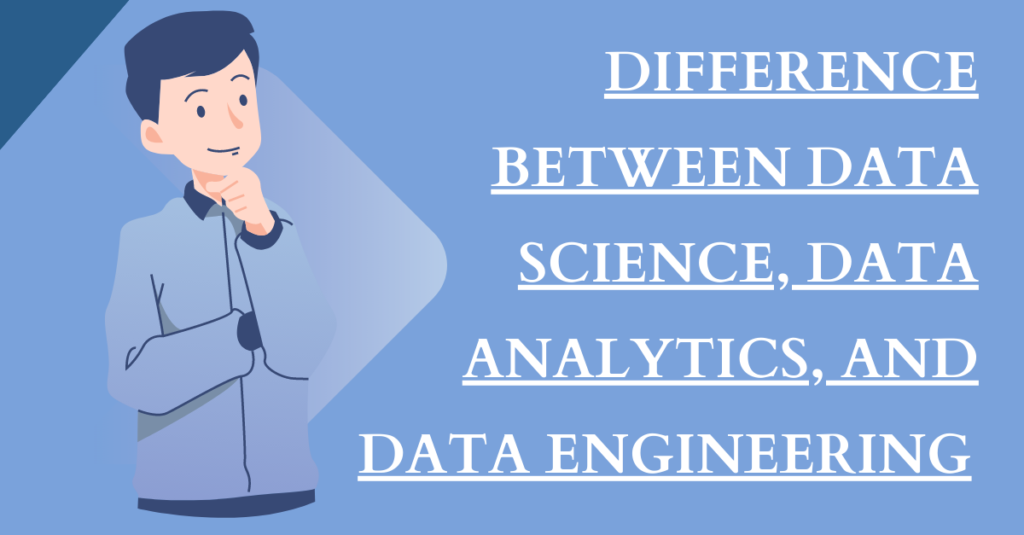Difference Between Data Science, Data Analytics, and Data Engineering
Introduction
In the realm of data-driven decision-making, three pivotal disciplines play distinctive yet interconnected roles: Data Science, Data Analytics, and Data Engineering. While often used interchangeably, these fields encompass diverse methodologies and expertise, each contributing uniquely to the data lifecycle. This article illuminates the precise disparities between Data Science, Data Analytics, and Data Engineering, unraveling their individual contributions to the extraction, analysis, and utilization of valuable insights from data. By delving into the specific responsibilities, skill sets, and applications within each realm, we embark on a journey to demystify these critical domains. Whether you’re charting a career path, seeking to optimize data utilization, or simply curious about the data landscape, this exploration will carve a clear roadmap through the intricacies of these essential disciplines.
Data Science: Unveiling Patterns and Predictions

At the forefront of the data revolution stands Data Science – a multidisciplinary domain that amalgamates advanced statistical analysis, machine learning, and domain expertise to uncover patterns, extract insights, and predict future trends. Data scientists are the modern-day alchemists, transforming raw data into gold – actionable intelligence that drives strategic decision-making.
Key Responsibilities and Tasks:
- Problem Formulation: Data scientists possess the acumen to translate complex business challenges into well-structured data problems, ensuring that analytical solutions are aligned with organizational objectives.
- Data Collection and Preprocessing: Raw data is rarely pristine; data scientists are adept at cleaning, transforming, and preprocessing data to ensure accuracy and consistency.
- Model Selection and Algorithm Development: Armed with an arsenal of machine learning algorithms, data scientists select and fine-tune models that best suit the specific problem at hand.
- Feature Engineering and Selection: Crafting meaningful features from raw data enhances model performance, and data scientists excel in extracting relevant features.
- Model Training, Validation, and Evaluation: Data scientists deploy rigorous methodologies to train, validate, and evaluate models, ensuring their robustness and reliability.
Skill Set and Qualifications: Data scientists typically possess expertise in programming languages like Python or R, proficiency in machine learning libraries, and a strong grasp of statistical concepts. A background in mathematics, computer science, or a related field is commonly sought.
Application Examples: Data scientists engineer fraud detection algorithms for financial institutions, predict customer churn for e-commerce platforms, and even enable personalized healthcare treatment plans by analyzing medical data.
Data Analytics: Deciphering Insights and Driving Business

While Data Science focuses on prediction and pattern recognition, Data Analytics centers on examining historical data to extract actionable insights that guide informed business decisions. Data analysts serve as storytellers, translating complex data narratives into comprehensible insights for stakeholders at all levels.
Key Responsibilities and Tasks:
- Data Exploration and Visualization: Data analysts utilize visualization tools to transform raw data into interactive graphs and charts, facilitating the discovery of meaningful trends and outliers.
- Descriptive and Diagnostic Analysis: By analyzing historical data, data analysts explain what has happened and why, unraveling the factors behind observed trends and anomalies.
- Statistical Analysis and Hypothesis Testing: Data analysts employ statistical methods to validate hypotheses, providing evidence-backed conclusions.
- Business Intelligence and Reporting: Timely and concise reporting of key performance indicators equips decision-makers with the information needed for strategic planning.
Skill Set and Qualifications: Proficiency in data manipulation tools like SQL, along with data visualization tools like Tableau or Power BI, forms the backbone of a data analyst’s skill set. A strong analytical mindset and the ability to communicate insights effectively are also crucial.
Application Examples: Data analysts dissect sales data to optimize pricing strategies, interpret website traffic patterns to enhance user experience, and assess marketing campaign effectiveness through A/B testing.
Data Engineering: Building the Foundation of Data

While Data Science and Data Analytics operate on the front lines, Data Engineering functions as the unsung hero in the background – laying the infrastructure that supports data acquisition, storage, and seamless accessibility. Data engineers are the architects who construct the data pipelines and warehouses that enable efficient data utilization.
Key Responsibilities and Tasks:
- Data Collection and Storage Design: Data engineers design and implement data collection systems, ensuring that data is efficiently captured and stored.
- Data Transformation and Integration: Raw data from disparate sources often requires integration and transformation to create a unified, usable dataset.
- Database Management and Optimization: Ensuring data availability, security, and performance is a critical responsibility of data engineers who manage databases.
- ETL (Extract, Transform, Load) Processes: Data engineers develop ETL pipelines that automate the extraction, transformation, and loading of data into storage systems.
- Data Pipeline Development: Constructing data pipelines that connect various data sources to analytical tools ensures a smooth flow of data.
Skill Set and Qualifications: Data engineers possess proficiency in programming languages like Java, Scala, or Python, as well as expertise in database management systems (DBMS) and data warehousing solutions. Knowledge of cloud platforms and big data technologies is becoming increasingly valuable.
Application Examples: Data engineers design and maintain data warehouses for online retailers, build real-time data streaming platforms for social media analytics, and develop robust ETL pipelines for financial institutions to process transactional data.
Differences and Overlaps: Navigating the Landscape
While Data Science, Data Analytics, and Data Engineering each hold distinct roles, they share symbiotic relationships that collectively drive data-driven decision-making. Visualizing their interactions through a Venn diagram highlights the nuances:
[Diagram: Data Science, Data Analytics, and Data Engineering overlapping in different areas.]
Skill Sets and Expertise:
- Data Science: Advanced statistical analysis, machine learning, domain expertise.
- Data Analytics: SQL, data visualization, analytical thinking.
- Data Engineering: Database management, ETL processes, big data technologies.
Focus Areas and Objectives:
- Data Science: Predictive modeling, pattern recognition, future insights.
- Data Analytics: Historical analysis, actionable insights, business optimization.
- Data Engineering: Data infrastructure, pipeline development, storage solutions.
Collaborative Relationships:
- Data Science: Collaborates closely with data analysts to translate insights into predictive models.
- Data Analytics: Works hand-in-hand with data engineers to access and process data effectively.
- Data Engineering: Supports data scientists and analysts by providing accessible, clean data.
Cross-Functional Impact:
- Data Science: Guides strategic decisions and innovation through predictive insights.
- Data Analytics: Influences business strategy by identifying trends and opportunities.
- Data Engineering: Underpins efficient data utilization, enabling accurate analysis.
Conclusion: Navigating the Data Landscape
In the ever-evolving landscape of data, Data Science, Data Analytics, and Data Engineering emerge as the pillars that drive organizations forward. While each field possesses its distinct expertise, they seamlessly converge to harness the power of data and empower informed decision-making. As businesses continue to recognize the invaluable potential of data, understanding the differentiating factors between these disciplines becomes paramount. By navigating this intricate web, individuals and organizations alike can capitalize on their collective strengths, propelling themselves towards data-driven success in an increasingly interconnected world.

My name is Rohit Vagh and I’m a content writer specializing in fashion and lifestyle. I have three years of experience in this field and have written various articles. My writing style is creative and engaging, and I strive to create content that resonates with my readers. I have a deep passion for fashion and am constantly researching the latest trends and styles to make sure my readers are up to date. I’m excited to continue my career in blogging, and I’m always looking for new opportunities in the fashion and lifestyle space.





